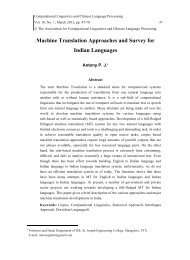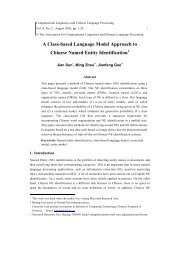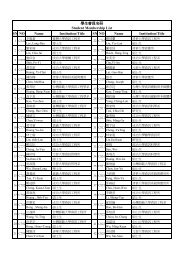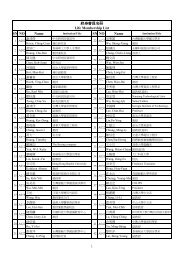Automatic Recognition of Cantonese-English Code ... - Aclclp.org.tw
Automatic Recognition of Cantonese-English Code ... - Aclclp.org.tw
Automatic Recognition of Cantonese-English Code ... - Aclclp.org.tw
Create successful ePaper yourself
Turn your PDF publications into a flip-book with our unique Google optimized e-Paper software.
288 Joyce Y. C. Chan et al.<br />
3.1 Corpus Design<br />
There are three different types <strong>of</strong> utterances in CUMIX:<br />
1. <strong>Cantonese</strong>-<strong>English</strong> code-mixing utterances (CM)<br />
2. Monolingual <strong>Cantonese</strong> utterances (MC)<br />
3. Monolingual <strong>English</strong> words and phrases (ME)<br />
The CM utterances represent the typical code-mixing speech being dealt with in our<br />
application. There are practical difficulties in designing the content <strong>of</strong> code-mixing sentences.<br />
This is because spoken <strong>Cantonese</strong> is considered as a colloquial language that mainstream<br />
written publications do not use. Although the grammar <strong>of</strong> spoken <strong>Cantonese</strong> is similar to that<br />
<strong>of</strong> standard written Chinese, the lexical preference is quite different. An example pair <strong>of</strong><br />
spoken <strong>Cantonese</strong> and written <strong>Cantonese</strong> sentences is shown in Table 4. Spoken <strong>Cantonese</strong><br />
rarely appears in published text materials. Thus, text materials that involve code-mixing <strong>of</strong><br />
spoken <strong>Cantonese</strong> and <strong>English</strong> are very limited.<br />
Table 4. Comparison <strong>of</strong> spoken <strong>Cantonese</strong> and standard Chinese<br />
Written Chinese: 你 吃 過 午 飯 了 嗎 ?<br />
Spoken <strong>Cantonese</strong>: 你 食 咗 晏 未 ?<br />
<strong>English</strong> translation (word by word): You eaten lunch or not?<br />
<strong>English</strong> translation (whole sentence): Have you had lunch?<br />
The design <strong>of</strong> CM sentences in CUMIX was based on a few local newspapers and online<br />
resources, including newsgroups and online diaries. We also consulted previous linguistic<br />
studies on <strong>Cantonese</strong>-<strong>English</strong> code-mixing. In Chan (1992), about 600 code-mixing sentences<br />
were analyzed. In 80% <strong>of</strong> the cases, the <strong>English</strong> segment contains a single word. The<br />
percentage distribution <strong>of</strong> nouns, verbs, and adjectives/adverbs are 43%, 24%, and 13%,<br />
respectively. There are very few cases involving prepositions and conjunctions. We try to<br />
follow these distributions in our corpus design.<br />
A total <strong>of</strong> 3167 distinct code-mixing sentences were manually designed. Each sentence<br />
has exactly one <strong>English</strong> segment, which may contain one or more words. There are a total <strong>of</strong><br />
1097 distinct <strong>English</strong> segments. Each <strong>of</strong> them may appear more than once in the corpus, and if<br />
it does, the <strong>Cantonese</strong> contents <strong>of</strong> the respective sentences are different. The selected <strong>English</strong><br />
words/phrases are commonly found in code-mixing speech and cover different part-<strong>of</strong>-speech<br />
categories.<br />
The monolingual <strong>Cantonese</strong> sentences (MC) are identical to the CM sentences except<br />
that the <strong>English</strong> segments are replaced by the corresponding <strong>Cantonese</strong> words. The number <strong>of</strong><br />
distinct MC sentences is smaller than that <strong>of</strong> CM ones because some <strong>of</strong> the <strong>English</strong> segments<br />
do not have <strong>Cantonese</strong> equivalents. Table 5 gives an example pair <strong>of</strong> CM and MC sentences.









